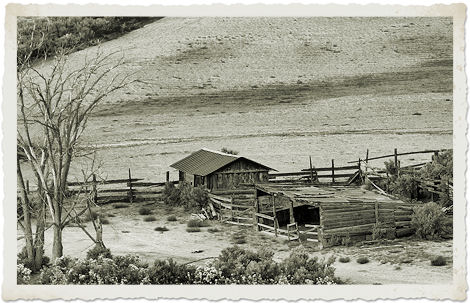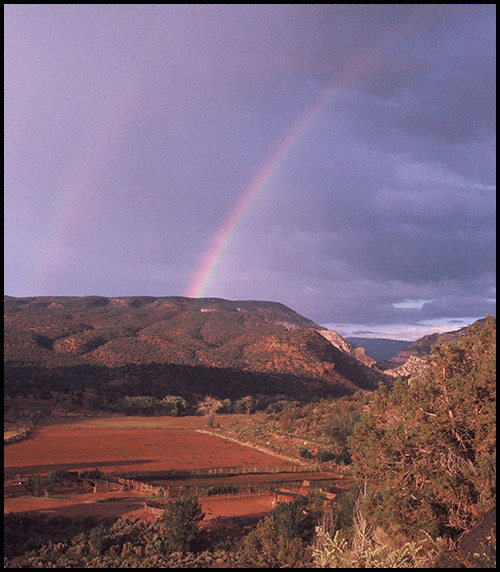Where Pleasant Creek breaks free from its narrow canyon walls upstream from Capitol Reef Field Station and before it cuts through the Waterpocket Fold downstream, it nourishes a small oasis of tall grasses, wildflowers, shade-giving cottonwoods, and aromatic sagebrush. Pleasant Creek has been a sanctuary for a very long time. Over millennia, it has been used by late Paleo-Indian, Desert Archaic, Fremont, and Numic-speaking (Ute and Paiute) peoples. We are drawn here for many of the same reasons that people have been drawn here for thousands of years. We appreciate the beauty around us—the soul-lifting sheer canyon walls, the perennial desert stream, and views of the Henry and Boulder Mountains.

The modern record of human settlement at Capitol Reef Field Station begins with the inscription, "J. L. Ivie 1876," on a nearby canyon wall. Soon after that, in 1882, Ephraim Hanks, a Mormon pioneer, established the first ranch here. Hanks diverted water from Pleasant Creek to irrigate farm fields and an orchard of about 200 fruit trees. The blooming of these fruit trees each spring gave the ranch one of its earliest names, the Floral Ranch. Through the next several decades, the Floral Ranch had been owned by a succession of Ephraim's descendants and other settlers whose names are familiar in Wayne County to this day—Meeks and Hickman; Jackson and Curtis; Cook and Bullard.
In 1938, Lurt Knee and his wife Margaret were scouting the country looking for a spot to start a tour operation. The Knees' vehicle broke down near Tantalus Creek, and the ranch's owner, Levi Bullard, invited the couple to spend the night at the ranch before helping them extract their vehicle the next day. Lurt and Margaret liked what they saw and purchased five acres of the ranch that year. Two years later, the Knees purchased the entire ranch, on the border of what was then Capitol Reef National Monument.

Utah's redrock deserts were still mostly unknown in the nineteen-forties. The hordes of German vacationers, American mountain bikers, and camera buffs you can find on any sunny day today had not yet shown up. So Lurt ran occasional jeep tours and tried uranium mining up the South Draw. The mine didn't produce, and his first wife, Margaret, left him. He then married Alice Knee, a nurse who was working to bring better healthcare to the Navajo reservation when he met her.
When Capitol Reef National Monument expanded in 1969 and became a full-fledged national park in 1971, the Knees were supporters, recognizing the significance of the Park's unique resources. The Knees found themselves within Park boundaries, an ideal situation for a guest ranch. Together, Lurt and Alice built their guest ranch on the knoll top, with its spectacular panoramic views. The Knees called their property the Sleeping Rainbow Ranch after Capitol Reef's layers of colorful rock. They attributed the name to a legend told them by a Native American who worked for them. While no other source is known concerning the legend, the name was certainly a masterful piece of marketing, and it applied to the ranch for a longer period than any of its many other names. In fact, this bit of mythology spread to encompass the entire Waterpocket Fold as the Land of the Sleeping Rainbow.
Sleeping Rainbow Ranch included a small motel unit with a spectacular, knoll-top view of the Henry Mountains, a log lodge, a house trailer, cabins, and various outbuildings. Lurt constructed power and phone lines upstream through Pleasant Creek Canyon to Grover.
Although the guest ranch did not attract large numbers of visitors, it became a favorite of writers, artists, and, especially, photographers who came year after year to enjoy the unique setting. Alice's Arabian horses galloped through green pastures below the mesa. Wild asparagus grew abundantly along irrigation canals. A garden supplied fresh vegetables to guests who ate together and conversed on the lodge's dining porch. A family of foxes visited the kitchen door each evening looking for scraps. The ranch and Lurt's Jeep tours to remote slickrock wonders were featured in magazines like Arizona Highways.
The Knees closed the guest ranch in 1974, then leased it to Chip and Linda Ward in '76 and '77. Lurt continued to run jeep tours for the Ward's guests. In 1978, the Knees passed the ranch to the Park Service in a deal that included life tenancy for them. They continued to live there for several years until their health declined. When Lurt died in 1995, Alice was in a nursing home in Arizona and quit-claimed her rights to the National Park Service. Over the intervening years, the guest ranch buildings fell into disrepair.
Two decades after Sleeping Rainbow Ranch ceased operation and its properties became part of Capitol Reef National Park, Professor Paul Tayler of Utah Valley University (UVU) found Sleeping Rainbow Ranch—a perfect answer to his search for a field research and educational site. He and Capitol Reef National Park Superintendent Charles Lundy began working together with Jim Harris, Dean of the UVU School of Science to make Capitol Reef Field Station a reality. UVU President Kerry Romesburg soon joined in their vision, bringing early donor support. Eventually Al Hendricks succeeded Charles Lundy as park superintendent. Their work together set the standard for years of close collaboration between UVU and the National Park Service in creating a field station that is harmonious with its environment in its physical aesthetics, off-grid energy and water consumption, and Leave-No-Trace operations. The field station, designed by Mark Chalom, began operations on October 16, 2008.

Several visionary benefactors made the Capitol Reef Field Station possible. Bill and Margaret Pope donated a generous endowment for field station operations and program support. Then through the visionary and tireless grant development work of UVU Professor Elaine Englehardt and support from Senator Bob Bennett, the U.S. Congress awarded a generous appropriation toward building the field station. Under President William Sederburg's direction, UVU also provided significant financial support to complete the field station. Many more visionary and tireless supporters of the Capitol Reef Field Station toiled to make Capitol Reef Field Station possible. Professor Renée Van Buren served as the first field station director from 2008-2012. Professor Michael Stevens became director in 2012.
Capitol Reef Field Station began and continues as a partnership between the UVU and the National Park Service to use this special place to further each partner's mission. The National Park Service has always recognized the essential role of education in fostering respect for the natural and cultural resources protected by national parks. People who understand the resources around them are careful to protect them.
The pre-field station history of Sleeping Rainbow Ranch was adapted (or otherwise pilfered) from Al Hendricks (former Capitol Reef National Park Superintendent) and Chip Ward (Torrey, Utah)